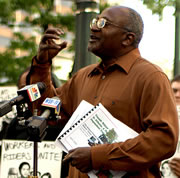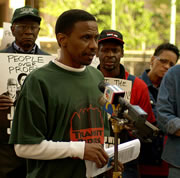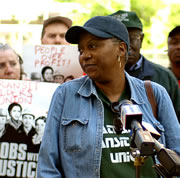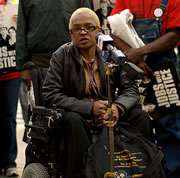Posted April 30, 2008
At long last, Atlanta Jobs with Justice has released their excellent study and plan for regional transit centered on the needs of riders and workers. You can download the report from Atlanta JwJ’s website or download it directly here. The study is the project of years of research and organizing with the Transit Riders Union – a group of transit-dependent riders and disabled riders – and workers in our transit system, MARTA, who are represented by Amalgamated Transit Union 732. This is in our corner of the ring.

ATU 732 president Benita West
On the side of the regional ruling class we have another plan, issued by the Transit Planning Board (TPB), a joint creation of the governing boards of several other confusing acronymns: GRTA (pronounced “Gerta” by some), ARC (usually spoken out by letter, Ay-Arr-See, despite “Arc” being much less clumsy than “Grta”) and MARTA. Locals call MARTA like it sounds, or more typically “the train” or “the bus,” referring to the 48 miles of heavy rail track or buses that wind their way through Atlanta. The system also includes paratransit service intended to provide door-to-door service for disabled people that seems to instead deliver endless headaches and terrible response times. Back in the day, some called MARTA “Moving Africans Right Through Atlanta” after its overwhelmingly Black ridership – an underfunded system limited in its goal of providing regional transportation by the stranglehold of white racism that still dominates city planning. At the

Dr. Bullard
press conference to unveil the people’s plan yesterday, environmental justice expert Robert Bullard made a remark that I remember as “TPB’s map is very ambitious. All these color-coded lines… and when they start color coding lines, well, you know….“
Yes, we do know. Anybody who looks at the history of so-called public transportation in this country should know. Transportation has always been a cornerstone of the racial order in this country.
Separate and Unequal
The era of legalized apartheid in the United States was bookended by two similar cases, both involved equal access to public transit. In 1892, the landmark Plessy vs. Ferguson Supreme Court ruling – the result of an attempt to challenge Louisiana’s segregated train cars – established Jim Crow as the law of the land. Sixty-three years later, Rosa Parks’ intervention in the segregated seating of Montgomery’s


Transit Riders Union co-chairs Chioke Perry and Sheila Adams
public buses sparked the first important mass action of the post-war Civil Rights movement. Just as the door to equality opened, however, it slammed back shut. Kevin Kruse’s excellent book White Flight: Atlanta and the Making of Modern Conservatism (order it through your local feminist or left-wing bookstore) shows how the desegregation of public facilities was met with abandonment of those same public services, a kind of “scorched earth” policy that marked the retreat of official white supremacy. Pools were filled in rather than being filled with integrated swimmers, public meeting places were shut down, and the extensive streetcar system – which had been the first in the country to officially segregate in 1890 – was ripped out of the ground.
White Flight and transit in the Atlanta “region”
Cue the birth of MARTA in 1972. Restricted to operation and funding in just the two counties that contain the city proper – Fulton and Dekalb – the system is nevertheless controlled by a board that includes representatives from the state of Georgia and several suburban counties that pay nothing. Meanwhile, $billions of funding pours towards the congested highways that have fertilized the growth of suburbs and exurbs deep into the mountains and countryside.

Laurel Paget-Seekins, TRU member
Public transportation’s perpetual budget crisis reminds me of Lee Atwater, the Republican strategist:
“You start out in 1954 by saying, “Nigger, nigger, nigger.” By 1968 you can’t say “nigger”—that hurts you. Backfires. So you say stuff like forced busing, states’ rights and all that stuff. You’re getting so abstract now [that] you’re talking about cutting taxes, and all these things you’re talking about are totally economic things and a byproduct of them is [that] blacks get hurt worse than whites.”
Instead of the regional transportation under a unified system promised by MARTA’s name, the “region” becomes the city and mediocre regional transportation is provided instead by a county-by-county patchwork of local, private bus systems that feature terrible service and the occasional exploding bus (due to bad maintenance; read the report). Transit workers in local 732 also suffer from a maze of contracts, one for each system.
Privatization and Gentrification

Terence Courtney of Atlanta Jobs with Justice
The vision put forward by Jobs with Justice connects the state of public transportation not only to a history of racism in that sector, but also attacks on public services generally: Public Housing, schools, and Grady hospital. Because this discussion of regional transit is happening, and because transit workers and riders are relatively better organized than, say health care workers and Grady patients, the struggle around transit is an opportunity to move beyond a purely defensive campaign and advance an agenda counter to the profit motive. It’s also strong as a program that extends from a comprehensive regional plan down to small but concrete improvements in service standards: improved bus shelters, improved access for disabled riders, and so forth.
As in many cities, Atlanta’s demographics are turning inside-out; older intown neighborhoods are being gentrified, forcing poor African-American and white communities – as well as new international migrants and the wave of African-Americans moving back to the South – to populate the inner ring of suburbs. (An interesting article in The Atlantic speculates that in the coming decades, outer suburbs and exurbs may be the next slums.) This makes identifying a standard of service for transit dependent riders important, rather than just planning transit around current

Margo Waters of TRU and disAbility Link
populations. Today, it can take three hours to get from one suburb to another on public transportation; these types of trips will only become more common for the transit dependent.
Workers and Riders United for People-Centered Transit
The coalition represented at the press conference was inspiring: antipoverty and human rights activists, organized transit workers and riders, Concerned Black Clergy, radical academics, leaders of the militant disability community, public housing residents, and members of other public sector unions. We have exciting months ahead: deepening this base and allying with immigrant workers, students, and other unions. Venceremos!
I know that there are other transit rider organizations around the country – ATRU is inspired by the LA Bus Riders Union…. are any readers involved in these efforts?

Comments
2 responses to “A People Centered Plan for Atlanta’s Mass Transit”
New Orleans is a much smaller city that Atlanta or Detroit, but with a very high percentage of transit dependent folks. Before Katrina, the transit-dependent population was 20%. I lived in New Orleans in the late ’90s for four years without a car , and know many people that have lived here much longer and have never had a car.
Many of New Orelans’ poorest residents have been permanently displaced. While less of the city is now transit dependent, many segments of the population are heavily transit dependent, including most of the 12,000 homeless folks and many of the post-Katrina Latino day laborers.
The bus system is scaled back so much that people give up on riding (NORTA, the transit system says that ridership has been reduced as much as 75%; slightly above the cutbacks in service!), and due to a deep history of racism and local fiefdoms, the city’s bus system- like Atlanta’s- is not highly integrated into any regional network where suburbs pay their share of the fare.
To get from/ to the airport to downtown New Orleans by public transit requires riding the Airport Express on Jefferson Transit to Tulane and S. Carrollton Ave., then taking a Tulane bus to the CBD, or getting a Carrollton bus to one of the streetcars…inevitably a 1.5-2 hour journey.
New Orleans had a marvelous network of street cars, including what is likely the longest continuously running municipal street rail line in the world (St. Charles Streetcar). The streetcars were the locus of many a strikes, including the famed 1929 strike whose striking workers ate leftover meats on baguettes: birth of the “Po’ Boy sandwich!” Most of the lines were closed post-WWII until the early 1960s, the auto boom (cf that working class spatiality blog http://www.solidarity-us.org/node/1161)
Despite differences in size and the specifics of industry and capital flight, New Orleans has many of the attributes of Detroit that Dianne explains above.
Overall, I am very impressed by the Atlanta report and hope that it can be one of many catalysts in understanding and fighting policies of neoliberalism and continued disinvestment and selective reinvestment (ie gentrification) in cities. The Right to the City network http://www.righttothecity.org/ has done some important thinking in this matter. Dan La Botz’s Who Rules Cincinnati also should not be overlooked. http://www.cincinnatistudies.org/studies.html
The Atlanta report looks excellent! Detroit is in even worse shape than Atlanta because all we have is a tiny network of buses. Even getting from the airport to the city is a problem.
Like LA, 100 years ago Detroit had a system of street cars. But the Big Three wanted everyone to have cars so they got the streets paved over, installed some buses and built freeways. Since the end of WWII, as the population and jobs began moving out, it’s mainly the poor, old and African-American population who stayed.
Although we are a city of over 900,000, Detroit doesn’t have a department store or a national grocery chain. If you don’t have a car, however, you can take a bus to the mall and go to a movie or department store out there. There is some talk about (re)starting a light rail system, but scheme is very bare bones.
I really appreciate the report from Atlanta Transit Riders Union and JwJ and hope it can become something of a model!